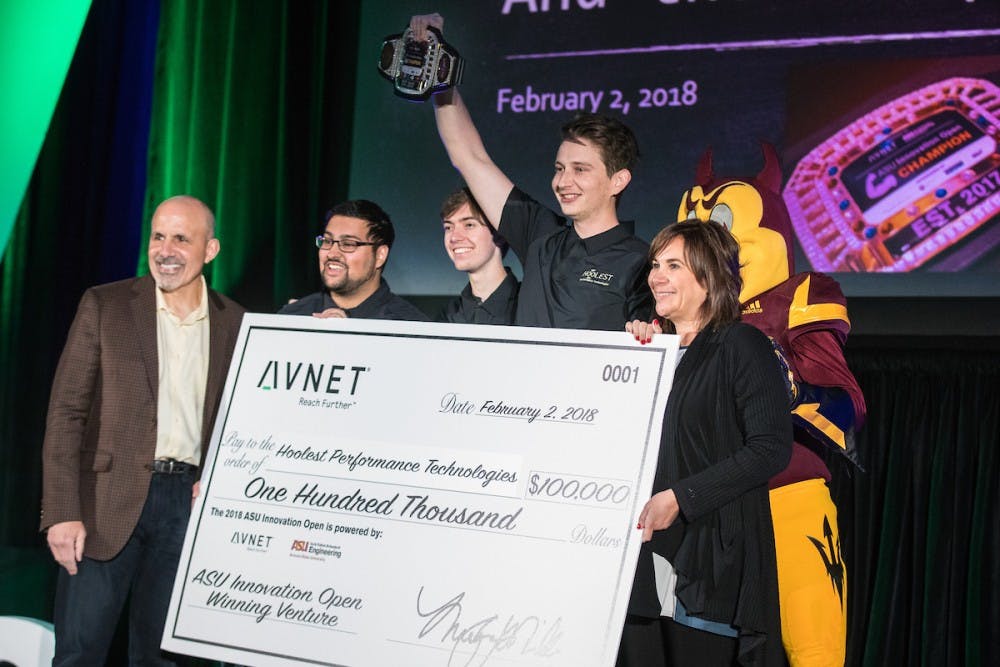ASU student-founded startup Hoolest Performance Technologies took home a $100,000 grand prize from the ASU Innovation Open for its electronic nerve stimulation technology.
The ASU-hosted competition, which is intended for new technology startups, was started last year. Somatic Labs, a wearable tech startup founded by two ASU students and a UA student, won the competition last year.
This year, the five finalists for the ASU Innovation Open were announced in Scottsdale on Feb. 2 at the Fairmont Scottsdale Princess Resort.
Hoolest took first place, the Tempe company AirGarage earned $20,000 and took third place and ASU startup Hygiea also earned grant money.
Hoolest, a company founded by biomedical engineering graduate student Nick Hool and two other ASU engineering students, specializes in electronic nerve stimulation.
The company produces stimulators in the shape of traditional earbuds designed to reduce performance stress and anxiety, The earbuds send electrical currents to stimulate the vagus nerve, which is responsible for the body’s natural relaxation response.
“When I walked into the room on the day of the semifinals, I was super nervous,” Hool said. “So I used the prototype that I had with me, and I actually turned it up to its highest setting. And when I started pitching, I felt great.”
The awards come from a sponsorship by Avnet, a Phoenix-based electronic component and embedded solutions distributor. Other sponsors included Zero Mass Water, Hool Coury Law, Salt River Project and ON Semiconductor.
Michael Hool, with Hool Coury Law, is Nick's father and removed himself from the competition's judging and deliberation. No one from Hool Coury Law was on the judges panel, according to ASU media relations.
The panel chose a first, second and third place winner, but Avnet later decided to give the other two companies who didn't finish in the top three grants as well.
Judges said that social impact was heavily considered in the decision to choose Hoolest Performance Technologies as the first place winner.
Competitors in the ASU Innovation Open submitted five-minute video pitches through ASU’s Venture Devils. The submissions were then narrowed down to semi-finalists who made in-person pitches on Dec. 2, 2017. After that, the finalists competed on Feb. 2.
Brent Sebold, the executive director of venture development at Entrepreneurship and Innovation at ASU, said the competition was a good chance for these startups to hear from CEOs and executives in business and technology, who could help them solidify their pitches.
“It’s an opportunity to mirror what happens in the real world for entrepreneurs,” Sebold said. “Competition makes everyone better.”
Sebold compared the ASU Innovation Open to collegiate sports, pointing out that ASU has 600 student-athletes competing against one another (and other schools), and the University has about the same number of student-entrepreneurs.
The application process is year round, and next year’s ASU Innovation Open is scheduled for a similar time frame.
Eric Leahy, director of sales for emerging business at Avnet, said this year’s ASU Innovation Open was a great success considering that they had three times the applicants and attendees compared to last year, and brought in more sponsor dollars.
“We had far more submissions, the quality of the submissions was higher, we were able to bring in another sponsor and then our event was well attended,” Leahy said. “I would say it was a good growth from the first year for sure.”
He said the highest percentage of applications were from ASU, that most of the applicants competed in the Venture Devils program and that the University has done a great job of encouraging companies to apply.
“We reviewed every applicant, we gave all of them feedback on things that they could improve and things that we liked,” Leahy said.
Leahy said that beyond a typical pitch, the panel looked for quality in a founding team, business and social impact and the progression point of the company.
Hool said most of Hoolest’s winnings will go toward producing a final product. While no time is set for the final product, beta versions will hopefully be coming in the summer.
“It’s going to take us a few months to get our final, final product,” Hool said.
He said their final would not be a rough prototype.
“We want to make this thing look as clean, as crisp and as appealing as possible," he said. "We’re going to spend the money on developing our first, final product, and then we’re going to kind of analyze it and produce roughly anywhere between 100 and 300 devices.”
Reach the reporter at maatenci@asu.edu or follow @mitchellatencio on Twitter.
Like The State Press on Facebook and follow @statepress on Twitter.




